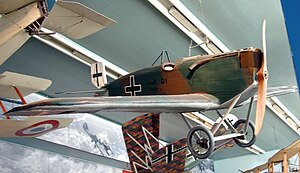Junkers D.I
| J 7 and J 9 (D.I) | |
|---|---|
 |
|
| Junkers D.I survivor at Musée de l'Air et de l'Espace | |
| Role | Fighter |
| National origin | Germany |
| Manufacturer | Junkers |
| Designer | Hugo Junkers |
| First flight | 17 September 1917 |
| Introduction | 1918 |
| Status | retired |
| Primary user | Imperial German Navy |
| Produced | 1918 |
| Number built | 41 |
The Junkers D.I (factory designation J 9) was a monoplane fighter aircraft produced in Germany late in World War I, significant for becoming the first all-metal fighter to enter service. The prototype, a private venture by Junkers designated the J 7, first flew on 17 September 1917, going through nearly a half-dozen detail changes in its design during its tests. When it was demonstrated to the Idflieg early the following year it proved impressive enough to result in an order for three additional aircraft for trials. However, the changes made by Junkers were significant enough for the firm to redesignate the next example the J 9, which was supplied to the Idflieg instead of the three J 7s ordered.
During tests, the J 9 lacked the maneuverability necessary for a front-line fighter, but was judged fit for a naval fighter, and a batch of 12 was ordered. These were supplied to a naval unit by September 1918, which then redeployed to the Eastern Front after the Armistice.
One example survives and is on display in the Musée de l'Air et de l'Espace, at the Paris–Le Bourget Airport, 11km north of Paris, France. Several replicas have been built, including one on display at the Luftwaffenmuseum Berlin-Gatow.
Data from Holmes, 2005. p 32
General characteristics
Performance
Armament
...
Wikipedia
